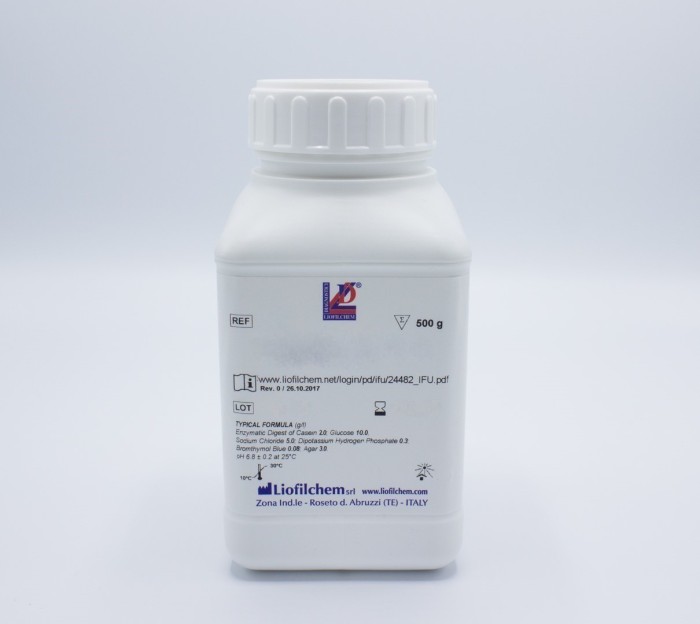Liofilchem™ Arginine Decarboxylase Broth, 500g
Catalog No :
CAS Number :
Brand :
In Stock
Specifications:
| Application | Microbiology | ||
| Storage Temperature | Ambient | ||
| Product Type | Culture Medium | Forms | Powder |
| Product Brand | Liofilchem | ||
| Product Grade | Microbiology grade | ||
Dehydrated Medium for the Differentiation of Gram-Negative Enteric Bacilli Based on Arginine Decarboxylation
Arginine Decarboxylase Broth is a specialized biochemical medium used for the differentiation of gram-negative enteric bacilli, particularly those belonging to the Enterobacteriaceae family. The medium is formulated to detect the production of arginine dihydrolase (also referred to as arginine decarboxylase), an enzyme that enables specific bacteria to metabolize arginine into putrescine, thereby shifting the pH of the medium.
Typical Formula (per Liter)
| Ingredient | Concentration (g/L) |
|---|---|
| Peptone | 5.0 |
| Meat Extract | 5.0 |
| Pyridoxal | 0.005 |
| Dextrose | 0.5 |
| L-Arginine | 10.0 |
| Bromocresol Purple | 0.010 |
| Cresol Red | 0.005 |
| Final pH | 6.0 ± 0.2 |
Principle of the Method
- Peptone and meat extract provide nitrogen, carbon, vitamins, and other growth factors.
- Dextrose serves as a fermentable carbohydrate to create an initial acidification.
- Bromocresol purple and cresol red are used as pH indicators.
- Arginine is included as the target amino acid for decarboxylation.
- Pyridoxal acts as a coenzyme for the decarboxylase activity.
Upon inoculation:
- Bacteria ferment dextrose, lowering the pH, turning the medium yellow.
- If the organism produces arginine dihydrolase, arginine is first hydrolyzed to ornithine and further decarboxylated to putrescine.
- The resulting alkaline environment shifts the medium back to purple, indicating a positive result.
If the organism does not produce arginine dihydrolase, the medium remains acidic (yellow) after glucose fermentation.
Preparation Instructions
- Suspend 21.0 g of powder in 1 L of distilled water.
- Heat until completely dissolved.
- Dispense into final test containers.
- Autoclave at 121°C for 15 minutes.
Test Procedure
- Transfer one or two colonies from a fresh culture using an inoculating loop.
- Inoculate the broth thoroughly.
- Overlay each inoculated tube with 1 mL of sterile Vaseline oil to promote anaerobiosis.
- Incubate at 36 ± 1°C for up to 96 hours.
Result Interpretation
| Color | Result | Interpretation |
|---|---|---|
| Purple | Positive Test | Arginine decarboxylation → Putrescine formation |
| Yellow | Negative Test | No decarboxylation, medium remains acidic |
Storage & Stability
- Dehydrated Medium: Store at 10–30°C, dry and sealed, in original container.
- Avoid moisture due to hygroscopic nature of the powder.
- Prepared Medium: Store at 2–8°C.
- Shelf Life: Use before expiry or if signs of contamination/deterioration appear.
Warnings & Precautions
- For in vitro diagnostic use (IVD) only.
- Must be used by trained laboratory professionals.
- Product is not classified as hazardous, but SDS should be consulted.
- Dispose of test materials per local regulations.
Disposal of Waste
Dispose of all used media, inoculated material, and containers according to national and local biosafety guidelines.
The Arginine Decarboxylase Broth is a reliable and essential medium for identifying bacterial metabolic capabilities, especially for distinguishing enteric bacilli based on arginine utilization. With a simple colorimetric readout and clear differentiation between positive and negative results, it is highly suited for clinical microbiology, food safety testing, and environmental labs.




 0
0
